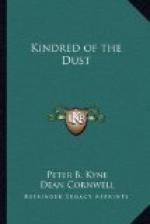“I can never live in Seattle until I retire, and I cannot retire until Donald takes my place in the business. That means that Donald must live here. Consequently, I shall spend half of my time with you and the girls in Seattle, mother, and the other half with Donald here. When we built our first home, you had your way—and I’ve lived in this architectural horror ever since. This time, I’m going to have my own way—and you’ve lived with me long enough to know that when I declare for a will of my own, I’ll not be denied. Well I realize you and the girls have outgrown Port Agnew. There’s naught here to interest you, and I would not have woman o’ mine unhappy. So plan your house in Seattle, and I’ll build it and spare no expense. As for this house on the headland, you have no interest in it. Donald’s approved the plans, and him only will I defer to. ’Twill be his house some day—his and his wife’s, when he gets one. And there will be no more talk of it, my dears. I’ll not take it kindly of ye to interfere.”
II
At a period in his upward climb to fortune, when as yet Hector McKaye had not fulfilled his dream of a factory for the manufacture of his waste and short-length stock into sash, door, blinds, moldings, and so forth, he had been wont to use about fifty per cent. of this material for fuel to maintain steam in the mill boilers, while the remainder passed out over the waste-conveyor to the slab pile, where it was burned.
The sawdust, however, remained to be disposed of, and since it was not possible to burn this in the slab fire for the reason that the wet sawdust blanketed the flames and resulted in a profusion of smoke that blew back upon the mill to the annoyance of the employees, for many years The Laird had caused this accumulated sawdust to be hauled to the edge of the bight on the north side of the town, and there dumped in a low, marshy spot which formerly had bred millions of mosquitoes.
Subsequently, in the process of grading the streets of Port Agnew and excavating cellars, waste dirt had been dumped with the sawdust, and, occasionally, when high winter tides swept over the spot, sand, small stones, sea-shells, and kelp were added to the mixture. And as if this were not sufficient, the citizens of Port Agnew contributed from time to time old barrels and bottles, yard-sweepings, tin cans, and superannuated stoves and kitchen utensils.
Slowly this dump crept out on the beach, and in order to prevent the continuous attrition of the surf upon the outer edge of it from befouling the white-sand bathing-beach farther up the Bight of Tyee, The Laird had driven a double row of fir piling parallel with and beyond the line of breakers. This piling, driven as close together as possible and reenforced with two-inch planking between, formed a bulkhead with the flanks curving in to the beach, thus insuring practically a water-tight pen some two acres in extent; and, with the passage of years, this became about two-thirds filled with the waste from the town. Had The Laird ever decided to lay claim to the Sawdust Pile, there would have been none in Port Agnew to contest his title; since he did not claim it, the Sawdust Pile became a sort of No Man’s Land.




